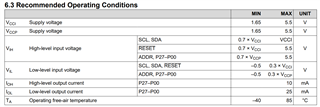Hi,
A question about TCA6424A IO pin voltage, if 5V rail on I/O pins as pull-up, but 3.3V is used on both Vcc and Vccp pins. will it have leakage current to Vcc and Vccp pins from 5V at I/O pins?
this statement on data sheet, not sure what meaning of " should not exceed the recommended level" .
If the I/O is configured as an output, Q1 or Q2 is enabled, depending on the state of the output port register. In
this case, there are low-impedance paths between the I/O pin and either VCC or GND. The external voltage
applied to this I/O pin should not exceed the recommended levels for proper operation.


